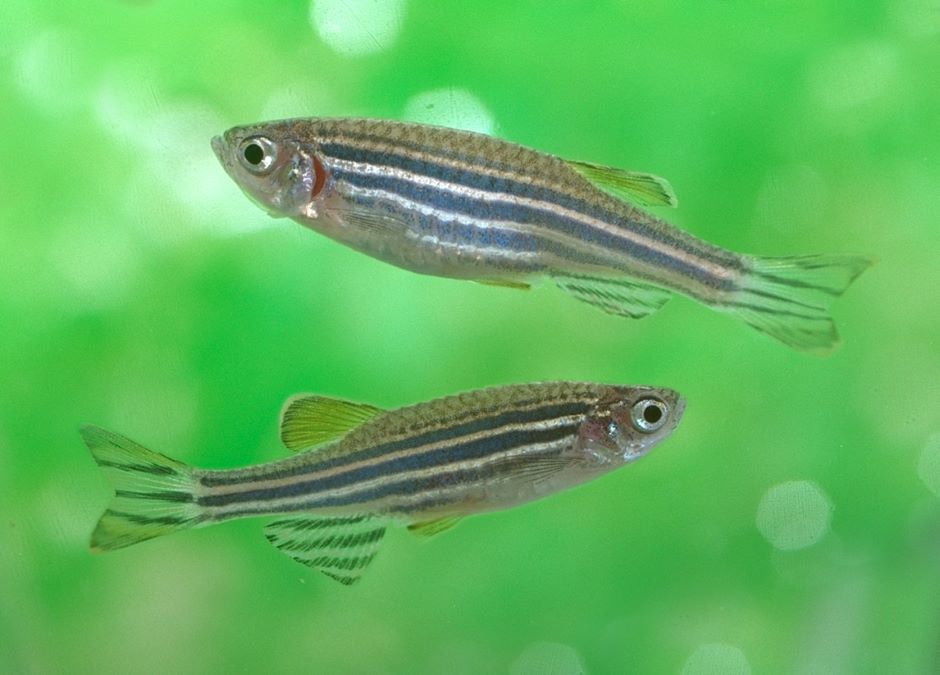Scientists Isolate Zebrafish Genes That Regenerate
 Zebrafish (Danio rerio) Adult zebrafish of AB strain. (Top) female and (bottom) male. (Credit: Tohru Murakami via Flickr CC BY-NC 2.0)
Zebrafish (Danio rerio) Adult zebrafish of AB strain. (Top) female and (bottom) male. (Credit: Tohru Murakami via Flickr CC BY-NC 2.0)Epidemiologists and others who study diseases and illnesses are familiar with the use of zebrafish in trials that study human diseases. While the zebrafish and humans may seem far apart in the way of appearance, the two are actually far more similar than what meets the eye. According to the National Institute of Health, 70% of human genes are in zebrafish, making them a good precursor to human trials.
This connection between humans and fish-kind is not new—instead, researchers that study human evolution have long recognized humanity’s humble (and aquatic) roots. There are remnants of this evolution that still exist in how humans grow and develop. According to the BBC, one of these examples is how a fetus’ eyes will start out on the side of the head before moving inward toward the middle, which mirrors fish development.
Due to this aquatic background, researchers are highly interested in looking at human’s distant ancestral cousins in order to develop a better understanding of human evolution. Furthermore, the similarities between modern-day fish and humans could mean that fish research has the potential to change how scientists look at medicine, treatments, diseases and a host of other issues impacting the world.
Finding the Differences between Humans and Zebrafish
Zebrafish are a popular choice when it comes to health-related research due to their unique regenerative abilities. Zebrafish, of course, are not alone as this trait can be found in several parts of the animal kingdom, both on land and in the water, though it seems humans did not maintain this evolutionary trait. However, researchers are hopeful that developing an understanding of these genes could help develop treatments for humans.
To try and understand these genes, researchers have built a running list of genes that enable regenerating animals to grow back tails or damaged tissues. And in some cases, they have found that genes important for regeneration in other creatures also have counterparts in humans.
Scientists at Duke University have found some of those genes in zebrafish, which they say can be turned on in injury sites. Some can even be engineered to change the ability of other animals to regenerate. Kenneth D. Poss, Ph.D., senior author of the study and professor of cell biology at Duke University School of Medicine, stated, “We want to know how regeneration happens, with the ultimate goal of helping humans realize their full regenerative potential [. . .] Our study points to a way that we could potentially awaken the genes responsible for regeneration that we all carry within us.”
To make the find, Duke researchers had to figure out if these stretches of DNA existed in the first place. They already knew that small chunks of sequence, called enhancer elements, control when genes are turned on in a developing embryo, so they began there.
Scientists looked for genes that were strongly induced during fin and heart regeneration in the zebrafish. They found that a gene called leptin b was turned on in fish with amputated fins or injured hearts. From there, researchers scoured the 150,000 base pairs of sequence surrounding leptin b and identified an enhancer element roughly 7,000 base pairs away from the gene.
From there, they whittled the enhancer down to the shortest required DNA sequence. In the process, scientists found that it could be separated into two distinct parts: one that activates genes in an injured heart and, next to it, another that activates genes in an injured fin. These parts were fused to two regeneration genes to create transgenic zebrafish whose fins and hearts had superior regenerative responses after injury.
Conclusion
While the scientists were able to learn a lot from the zebrafish, there are limitations to how the research can and should be applied. Despite the genetic similarities between zebrafish and humans, one glaring difference between the two is that humans are mammals. So despite all of the work conducted on the fish, mice were used to fill in the gaps. Scientists found that borrowing the elements from the genome of zebrafish could activate gene expression in the injured paws and hearts of the mice.
The results are an encouraging proof-of-concept, researchers say. And they think that there may be different types of sequences that turn on genes in many instances, as well as others that only work within specific tissues or in the embryonic stage.
Full results of the investigation are published in the journal Nature.


Pingback: FishSens Magazine | How Atrazine Impacts Aquatic Systems - FishSens Magazine